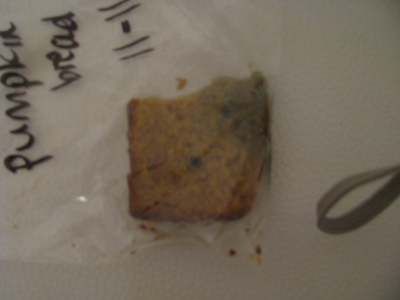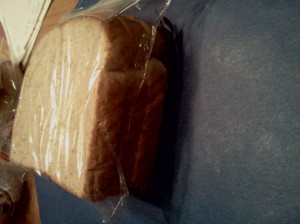The pumpkin bread has continued to have a fairly large amount of mold growth. These pictures show the mold growth on the 17th day of this pumpkin bread.
 This is the “Old Fashion Biscuit” and you can’t really tell in the picture, but it has a considerable amount of mold growth across the top of the biscuit. It’s almost like a dusty mold. This picture is from the 29th day.
This is the “Old Fashion Biscuit” and you can’t really tell in the picture, but it has a considerable amount of mold growth across the top of the biscuit. It’s almost like a dusty mold. This picture is from the 29th day.
 This shows a spot of mold growth on the “Buttermilk Biscuit”. This picture is from day 16. So we can see that the buttermilk biscuit, again, grew mold quicker than the Old Fashion biscuit, although it didn’t necessarily grow more.
This shows a spot of mold growth on the “Buttermilk Biscuit”. This picture is from day 16. So we can see that the buttermilk biscuit, again, grew mold quicker than the Old Fashion biscuit, although it didn’t necessarily grow more.

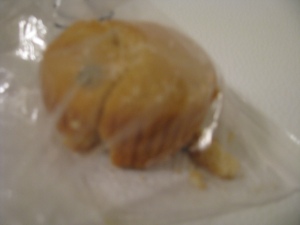 Here you can begin to see mold growth on the vanilla cupcake. This is from day 30. The cupcake took longer to grow mold than most of the other breads… I’m wondering if this has something to do with the amount of sugar it has in it… I’m going to research the effects of sugar as a preservative.
Here you can begin to see mold growth on the vanilla cupcake. This is from day 30. The cupcake took longer to grow mold than most of the other breads… I’m wondering if this has something to do with the amount of sugar it has in it… I’m going to research the effects of sugar as a preservative.

 These pictures show the mold growth on the hamburger buns where there were two put in the Ziploc bag. This is day 17, and they’re continuing to grow moold more rapidly than most of the others.
These pictures show the mold growth on the hamburger buns where there were two put in the Ziploc bag. This is day 17, and they’re continuing to grow moold more rapidly than most of the others.
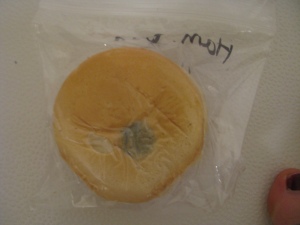 In the Ziploc bag with only one hamburger bun, a spot of mold has appeared on the bun. This picture is also from day 17.
In the Ziploc bag with only one hamburger bun, a spot of mold has appeared on the bun. This picture is also from day 17.
The Kroger wheat bread still shows NO signs of mold growth!!!!!
Hamburger Buns: DAY 12
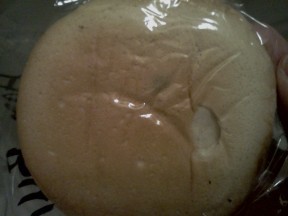 You can see a little green spot in almost the middle on the bottom of the bun.
You can see a little green spot in almost the middle on the bottom of the bun.
 There’s also some mold growth on the side of one bun.
There’s also some mold growth on the side of one bun.
Both of these occurances were with the bag that included 2 hamburger buns. The one containing only one hamburger bun hasn’t grown any mold yet. So that shows me there is some correspondence in mold growing faster and the quantity on the bread in a single container being higher. I was also correct in the the hamburger buns were one of the first things to mold. This faster growth makes sense because these buns are what led me to question bread mold in the first place!
Pumpkin Bread: DAY 11
There was a green spot of mold on the pumpkin bread as well as some mold on one corner (the second picture, which you may not be able to see very well). So the pumpkin bread ended up actually being the first type to show significant mold growth. This makes sense, because it contains quite a bit of canned pumpkin, which I would think would speed of the molding process, becuase it’s technically a “vegetable” being kept at room temperature.
I have started by experiments by choosing different types of bread both homemade and store bought, placing them in Ziploc bags, and storing them all in the same place in the pantry. I chose to store them all in the same place, so that I could be certain temperature or lighting wasn’t affecting the different rates at which they began to mold. Here are the breads I’ve started with:
Kroger brand white hamburger buns: I decide to put one hamburger bun in a ziploc bag, two in another, and then leave the other five in the bag they came in to determine whether proximity to other breads contributes to the speed at which the bread molds.
The ingredients for these hamburger buns are:
- unbleached enriched flour
- water
- high fructose corn syrup
- yeast
- wheat gluten (contains less than 2%)
- salt (contains less than 2%)
- vegetable oil (contains less than 2%)
- dough conditioners (contains less than 2%)
I also included the type of bread I typically buy for sandwiches, which is Kroger brand wheat bread. I put one slice of this bread in a ziploc bag and three slices of it in another to again determine if being kept with more than one slice speeds up the rate at which the bread molds.
I guess this is a good time to include my thinking on this variation.. I think that the breads contained in a Ziploc bag with more than one slice or bun will mold faster than the ones that are in the Ziploc bags alone. I think the breads will maintain more moisture when kept with more than one piece, and moisture is something which I know speeds mold growth.
Ingredients of the Kroger wheat bread:
- enriched unbleached flour
- water
- whole wheat flour
- high fructose corn syrup
- yeast
- salt (contains less than 2%)
- molasses (contains less than 2%)
- soybean and/or canola oil (contains less than 2%)
- caramel color (contains less than 2%)
- wheat gluten (contains less than 2%)
- soy flour (contains less than 2%)
- dough conditioners (less than 2%)
I am also including some pumpkin bread I made a few days ago. I think this bread may mold quicker than some other because 1. it’s more moist, and 2. I think the presence of pumpkin, a vegetable, will speed up the process.
Ingredients of the pumpkin bread: (This will be a more precise list since I actually made it.)
- vegetable oil (1/3 cup)
- canned pumpkin (1 cup)
- eggs (3)
- Bisquick (2 1/3 cups) (Bisquick contains: enriched flour bleached, partially hydrogenated soybean and/or cottonseed oil, leavening, dextrose, and salt)
- sugar (1 1/4 cups)
- ground cinnamon (2 teaspoons)
I also baked two different types of biscuits that I’m including in the experiment. The first are “Old Fashioned Biscuits” and they only contain three ingredients! I think this particular bread isn’t going to mold, but is simply going to become very stale. I may end up sprinkling some water on all the breads if mold isn’t seeming to appear (because this project is due in a few weeks and I’d like to see some mold before then!), and then it may grow a bit, but I’m thinking it definitely won’t grow any before then.
Ingredients for “Old Fashioned Biscuits”:
- shortening (1/4 cup)
- self-rising flour (2 cups)
- milk (2/3 cup)
I also made “Buttermilk Biscuits”, and, again, I think these biscuits will simply become stale unless I sprinkle some water on them . If both these types of biscuits have water sprinkled on them, I think this, “Buttermilk”, type will mold quicker, because buttermilk is actually a variation on sour milk, which I would think will cause it to mold faster than the biscuits above that were made with regular milk.
Ingredients for “Buttermilk Biscuits”:
- buttermilk (2/3 cup)
- baking soda (1/4 teaspoon)
- self-rising flour (2 cups)
- shortening (1/3 cup)
Buttermilk
I also wanted to test one of the homemade vanilla cupcakes I baked for Halloween a couple of weeks ago. I’m thinking maybe because of the moistness a cupcake usually has as opposed to the other types of bread, it may mold quicker than the others.. maybe closer to the rate of the pumpkin bread. However, it’s been two weeks now and I haven’t seen any mold growth on it (or any of the other types, although none of them have been out as long as the cupcake has been). The cupcake has so far only dried out and become a little harders and crumblier.
Ingredients in the vanilla cupcake:
- all-purpose flour (2 1/2 cups)
- baking powder (2 teaspoons)
- baking soda (1/2 teaspoon)
- salt (1/2 teaspoon)
- milk (1/2 cup)
- vegetable oil (1/2 cup)
- vanilla extract (1 teaspoon)
- unsalted butter (1 stick)
- sugar (1 cup)
- eggs (3)
I plan to add a couple others this week as well….still trying to decide what types…
I still think the hamburger buns will mold the fastest, since that’s what I’ve observed in the past. I don’t think I’ll see any mold growth on the biscuits unless I add water. If this proves to be true, I’d like to figure out why. I think I’ll see growth on both the cupcake and pumpkin bread sometime in the next ten days. I think the slices of wheat bread won’t start to mold at least for another couple weeks, but I definitely think they’ll mold before the biscuits.
These next pictures have nothing to do with my project… but I couldn’t resist.. 🙂
This is my goofy husband with the pumpkin bread I didn’t set aside to mold 😉
And these are the adorable children I babysit decorating the cupcakes I (again) didn’t set aside to mold!
I changed my mind on the project I want to work towards!!!!
I have noticed that hamburger buns mold faster then anything else! I have to keep them in my refridgerator or they will always mold before we use them all. And I’m not talking about a couple green spots.. I mean it is COVERED in mold. This just happened and I really wish I had taken a picture to show you, but unfortunately I threw it away. I am really interested in figuring out why this type of bread molds so much quicker than all the others. I also buy regular Kroger wheat bread and it never molds before I use it all, and it’s not like I use it all in a few days.. it’s usually at least a couple weeks. These two breads are kept on the same shelf in the same pantry, so I know the difference in the molding can’t be related to their location; it must have to do with their ingredients.
I’m going to start by comparing ingredients in different types of bread and seeing if there’s sosmething absent in one type, but present in the other, or if there’s a difference in the amount of certain ingredients. Then I’ll be observing how fast each type molds as well as how much mold they grow. I’m also going to bake some bread and see if that molds in less time or more time than store bought breads this will be helpful because I will know exactly how much of each ingredient goes into the homemade bread.
I will be taking a lot of pictures of this process so you can follow me and see which types of molding and which types aren’t. I’m really excited to see what I can figure out!!!
A child in your class says, “I hate math! I’m not good at math, and I never will be!” What experiences do you think this child has had in his/her life that contributes to this child’s feelings about his or herself, math, and his or her relationship to math?
Figuring out why students feel the different ways, whether positive or negative, is an important part of being a good teacher. If we figure out the negative, we can prevent it in our classroom. If we figure out the positive, we can reinforce this in our classroom. Based from just my own experience and observation, I have a couple ideas for why this child may “hate math”. If this was an older child, this “hatred” could stem from a pressured, whether internal or external, to maintain high grades. Perhaps math has been an area in the past year or so where the student hasn’t maintained high grades, and therefore they’ve developed a dislike for it because it’s not coming very easily. When students are focused only on grades, they can develop this dislike in areas they aren’t getting high grades. I know this from personal experience. I have always been a “must get an A” student and felt like a failure if I didn’t make an A on a test or paper.
This distain from could, of course, stem from an experience with a not so great teacher. If, at especially an early age, this child wasn’t given proper instruction, it could have set them up for struggles in this subject as each grade builds and builds on what the student should have already learned. There’s also a very unfortunate chance that the student has been told they’re not good at math. Teachers hold so much sway with students, and we need to use this responsibly! What a teacher says, students believe. Indicating in any way that a student can’t do something, can affect that students attitude for the rest of their schooling. Perhaps this child’s previous teacher made small comment to the child about their ability. This may continue to deter their mathematics learning until another teacher convinces them otherwise. Students need someone to believe in them!
This reading about pendulum motion was very interesting (much more so than I thought it would be 😉 ). I knew the pendulum was involved in some way in keeping time on behalf of seeing it in grandfather clocks and such; however, I had no idea of the HUGE part in played in the development of time keeping from the start. I never wondered about how time started being kept.. and now I’m wondering how I never thought about it! What other discoveries do I take for granted every day and not give any thought?? What the reading said about the pendulum “indirectly changing culture and societies through its impact on navigation”, also got me thinking about science changing our society. We sometimes think of science as its own little bubble off by itself, not really effecting us or society unless a really life-changing discovery is made. We think of things like.. the atom bomb or a cure for cancer.. sure, those things have and would affect society, but not little things like swinging pendulums. Latitude and longitude is something I have actually wondered about; I took World Geography a couple semesters ago and founding myself thinking, those lines didn’t just appear on the earth.. so who decided where they should go? And did they use some sort of mathematical formula to put them there? Turns out, it was all about time measurement and therefore the pendulum! I enjoyed the explanation of the degrees, rotations, and time in the development of longitude and latitude. The author of the article wrote in such a way that it was very understandable, even if your not a physics major.
I like what the reading says Aristotle emphasized, which was “that science should be based on ordinary observation of phenomena”. This makes sense to me. The first example I thought of was the human body, which is definitely a phenomena that we take for granted every day. Our body works in such complex and intric ways, and biology and anatomy try to explain all these different workings by many, many observations of the body outside, inside, with microscopes, etc.
Honestly, I’m not really sure what to make of the Aristotle/Galileo/del Monte dispute. I reread it a couple times and I’m still not completely grasping it. I think Aristotle’s thinking about science being what we observe is being used against Galileo, because del Monte couldn’t observe a swinging pendulum with complete accuracy and therefore found the theory wrong. I think we also have to be willing to think outside the box when it comes to science. For instance, who would’ve thought we would have all been able to come up with all these different ideas about a flashlight? We’re developing ideas based on things we can’t completely see and observe such as Galileo was doing with the pendulum. He uses this “ideal” situation to predict situations that will occur under real conditions. This reminds me a little bit about my team’s beam of light theory…. under ideal conditions where there are enough water particles in the air, you can see the beam of light. Because of what it seen under this “ideal condition”, we say that there must always be that beam of light; it’s just not visible without these particles.
For my first observation I decided to do what the first experiment represented, which was a flashlight shone down a dark hallway. I turned off all the lights in my house and had my husband hold a flashlight at one end of the hallway while I stood in a doorway along that hallway. The first look I took was simply looking straight out the doorway at the wall opposite me. The flashlight illuminated the entire wall and floor I was looking at. I could clearly see a picture hanging on the wall as well as a closed closet door. I thought this was interesting because it was similar to how the flashlight illuminated the entire box, except that, at this point, I couldn’t see a distinct circle of light illuminated on the wall as it was on all the walls (including the top and bottom) of the box.
I then turned out the doorway and look toward the source of the light (my husband holding the flashlight). At this angle, I COULD see a distinct beam of light! I found this so interesting because of how much time we’ve spent in class talking about this “beam”. Now it wasn’t a bright light such as one from a light saber, but there was definitely a distinct beam, although fairly dim, coming directly from the flashlight. This is what I’ve thought we would see all along; it must’ve been that the box in class didn’t allow enough room for the beam to be looked at from a specific angle and seen. Also looking at the flashlight from this angle, I could in fact see a few sparse particles floating in the air around the beam. This is an idea that my group has had from the beginning as well, and we actually developed an idea Wednesday (09-07-11) that you see a beam when there are more particles in the air such as dust, fog, smoke, etc. This angle was the only one at which I could see the floating particles and the distinct beam.
I turned again and looked at the end of the hallway opposite of the source of the flashlight. This time I did see a circle of light illuminated on a closed door just like we saw in the box, only larger of course. This makes sense because if there is a beam, this light is going to bounce off of an obstacle (in this case the door) with which it comes in contact. This circle was the brightest part of the hall just as the circle on the wall of the box was the brightest spot in the box. This end of the hallway was pretty lit in general as well.
I thought this reading was very interesting. The author of this passage seems to be an educator who obviously values the process and thinking used in reaching the answer to a problem over the problem itself, which is something I also hold as important in the teaching of students. He points out that knowing the right answer in an almost automatic way is much too overrated; the actual act of “figuring it out” isn’t counted like the answer to a problem known ahead of time. I think these are all excellent points he makes. It made me start wondering how, as a teacher, I will put emphasis on my students’ ability to figure out problems over just knowing the correct answer in a thoughtless way. It caused me to go back and think specifically about math teachers I’ve had who awarded points on tests, quizzes, etc. based on how you worked through a math problem (such as giving you partial credit if some of the work shown was correct or if you were using the correct thinking to solve the problem but somehow arrived at an incorrect solution) and how much this helped in those math classes! They made it more about knowing how to work the problems, which is what we ultimately want our students to know and remember whether it’s math, science, english, logical thinking, etc. I really enjoyed reading the example of the 6-year old and the different size glasses test. It was such a wonderful example of a child really learning and figuring the problem out! Students will remember something so much more if they are able to play a big role in reaching the solution instead of it just being handed to them to memorize. I also enjoyed reading the example of “Alec”; it really reminded me of the discussion we had in class Wedesday about light. Just like in this story, when students start sharing, fewer are scared to share their own ideas about why or how something’s happening (or in our case, going to happen). When the idea sharing starts, it allows students to scrutinize, question, etc. others’ and their own ideas, which leads to getting closer and closer to figuring out the given problem. In my opinion, this is an extremely effective way to conduct a science class as it gives the students an opportunity to arrive at a solution while developing ideas they never thought they could ever have! In this way, you actually make the student feel like the scientist.

